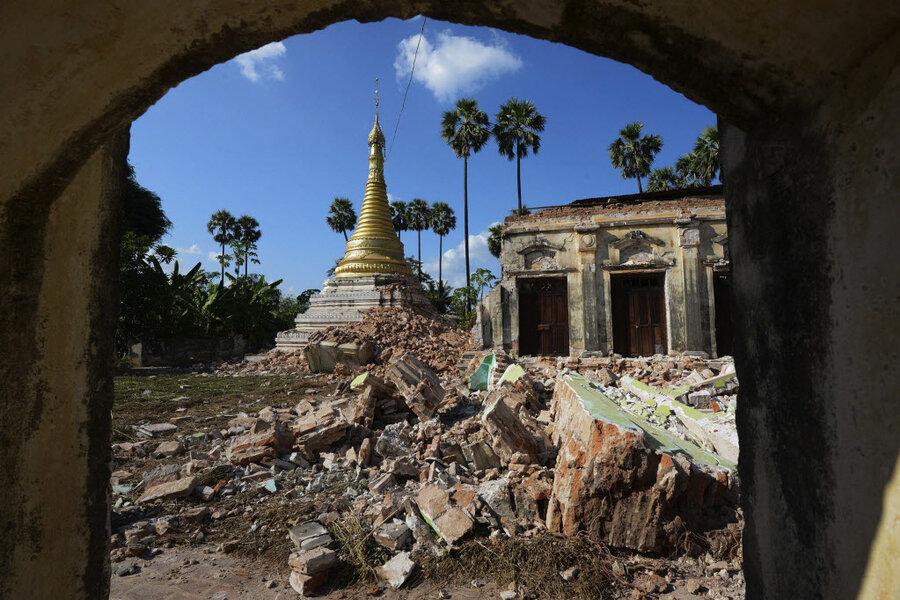A dozen feared dead after quake rattles Myanmar
Loading...
| Yangon, Myanmar
A strong earthquake of magnitude-6.8 struck northern Myanmar on Sunday, collapsing a bridge and a gold mine, damaging several old Buddhist pagodas and leaving as many as 12 people feared dead.
A slow release of official information left the actual extent of the damage unclear after Sunday morning's strong quake. Myanmar has a poor official disaster response system, despite having lost upwards of 140,000 people to a devastating cyclone in 2008.
Myanmar's second-biggest city of Mandalay reported no casualties or major damage as the nearest major population center to the main quake Mandalay lies about 72 miles south of the quake's epicenter near the town of Shwebo.
The US Geological Society reported a 5.8-magnitude aftershock later Sunday, but there were no initial reports of new damage or casualties.
Smaller towns closer to the main quake's epicenter were worse-hit. A report late Sunday on state television MRTV said 100 homes, some government buildings and a primary school were damaged in the Thabeikyin, a town known for gold mining not far from the epicenter. It put the latest casualty toll from the quake at four dead, 53 injured and four missing, a death toll lower than independently compiled tallies of around a dozen.
An official from Myanmar's Meteorological Department said the magnitude-6.8 quake struck at 7:42 a.m. local time.
The area surrounding the epicenter is underdeveloped, and casualty reports were coming in piecemeal, mostly from local media. The region is a center for mining of minerals and gemstones, and several mines were reported to have collapsed.
The biggest single death toll was reported by a local administrative officer in Sintku township — on the Irrawaddy River near the quake's epicenter — who told The Associated Press that six people had died there and another 11 were injured.
He said some of the dead were miners who were killed when a gold mine collapsed. He spoke on condition of anonymity because local officials are normally not allowed to release information to the media.
Rumors circulated in Yangon of other mine collapses trapping workers, but none of the reports could be confirmed.
According to news reports, several people died when a bridge under construction across the Irrawaddy River collapsed east of Shwebo. The bridge linked the town of Sintku, 40 miles north of Mandalay on the east bank of the Irrawaddy, with Kyaukmyaung on the west bank.
The website of Weekly Eleven magazine said four people were killed and 25 injured when the bridge, which was 80 percent finished, fell. The local government announced a toll of two dead and 16 injured. All of the victims appeared to be workers.
However, a Shwebo police officer, also speaking on condition of anonymity, said just one person was confirmed dead from the bridge's collapse, while five were still unaccounted for.
Weekly Eleven also said two monasteries in Kyaukmyaung collapsed, killing two people.
"This is the worst earthquake I felt in my entire life," Soe Soe, a 52-year-old Shwebo resident, told The Associated Press by phone.
She said that the huge concrete gate of a local monastery collapsed and that several sculptures from another pagoda in the town were damaged.
Other damage was reported in Mogok, a major gem-mining area just east of the quake's epicenter. Temples were damaged there, as were some abandoned mines.
"Landslides occurred at some old ruby mines, but there were no casualties because these are old mines," Sein Win, a Mogok resident, said by phone.
State television reported that more than a dozen pagodas and stupas in five townships were damaged, and many of them had their so-called "umbrellas" atop the dome-shaped structures crash down.
The uppermost parts of the domes usually contain encased relics of the Buddha and small Buddha images, and sometimes jewels. Damage to them is taken as an especially bad omen.
Sein Win said police were guarding a damaged stupa in Mogok and its exposed relics.
Many people in Myanmar are superstitious, and it is likely that local soothsayers will point out that the quake occurred on the 11th day of the 11th month.
A resident of Naypyitaw, which is 225 miles south of the quake's epicenter, said several windowpanes of the parliament building had broken.
The epicenter is in a region frequently hit by small temblors that usually cause little damage.
The quake was felt in Bangkok, the capital of neighboring Thailand. It comes just a week ahead of a scheduled visit to Myanmar by President Barack Obama. He will be the first US president to visit the one-time pariah nation, which is emerging from decades of military rule.
The disaster is the second to strike the area in three days. On Friday, a tanker train derailed about 80 miles north of Shwebo, and at least 25 people were killed when overturned carriages burst into flames as they were trying to skim fuel from them.







